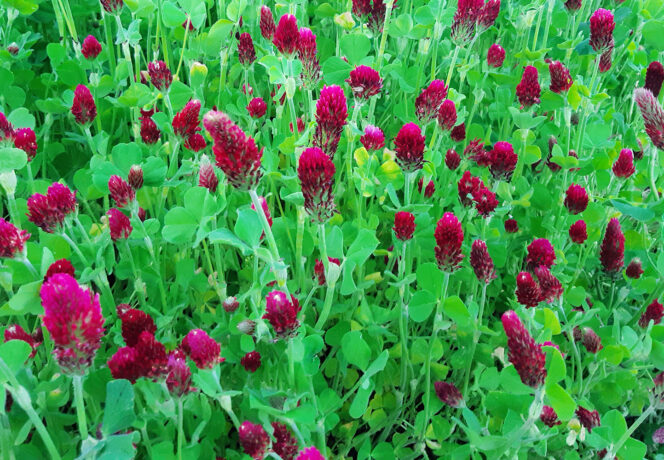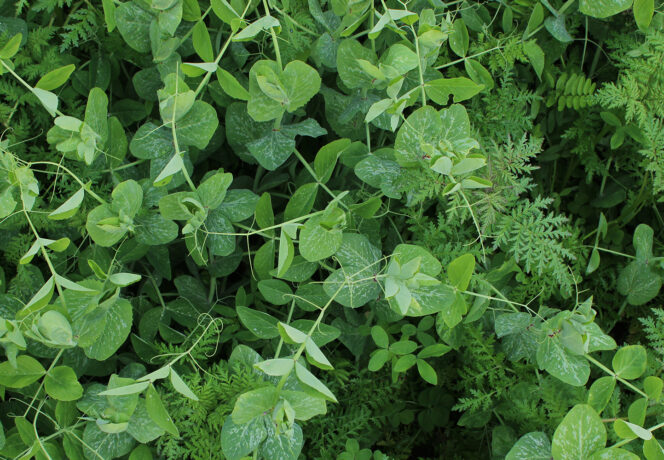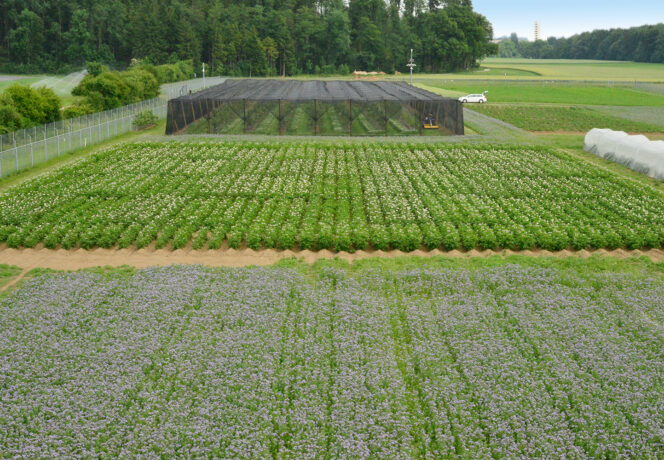
Archive
758 posts

Pest prevention plays an important role in reducing pesticide use. Nevertheless, the use of such measures is below the social optimum. A generally cautious attitude towards risk and adoption of other risk management measures hinder farmers' prevention efforts.

Temporary grassland: two new alfalfa varieties recommended
In temporary grassland, alfalfa is used mainly in three-year mixtures for dry locations. Following recent variety trials, Agroscope has added the new varieties Nutrix and Andantino to the list of recommended forage plants for 2023–2024.

From Niche Crop to Mainstream Success
Oats, triticale, hull-less barley, lupin, faba beans and buckwheat are rarely cultivated. The EU project CROPDIVA intends to change that. Agroscope analyses the value chains of four of these crops in order to promote their cultivation and processing.

New Merlot Clones for the Swiss Certification Sector
Five Merlot clones bred in Switzerland are currently being distributed by the certification sector. A multiyear trial conducted by Agroscope in Gudo (Canton of Ticino) has made it possible to compare them with French and Italian reference clones and to highlight their very good performances.

Beneficial Soil Fungi for Sustainable Plant Production
Arbuscular mycorrhizal fungi are important for healthy soils and crops. A pan-European study shows that plant-protection products adversely affect these fungi, reducing their ability to supply plants with phosphorus via their roots.

Two New Varieties of Birdsfoot Trefoil Recommended
Birdsfoot trefoil and sainfoin are used in mixtures for perennial hay meadows and for tannin-containing fodder. Agroscope is adding two new cultivars of birdsfoot trefoil to the ‘List of Recommended Varieties of Forage Plants’, whilst there is no change in the case of sainfoin.

Tall and Golden Oat Grass: Few New Good Varieties
Tall oat grass and golden oat grass are typical hay-meadow grasses that are also suitable for forage mixtures. Of the four tall and three golden oat grass varieties tested, only one new variety of tall oat grass is likely to make it onto the List of Recommended Varieties.

Bread Wheat Varieties in Organic Farming
FiBL and Agroscope investigated bread wheat varieties to determine their yield and quality stability. The results show that the choice of variety must be adapted to the site and that high yield potential does not go hand-in-hand with a high protein content.

Hybrid Ryegrass Combines the Best Features of Perennial and Italian Ryegrass
Adapted and high-yielding varieties of forage plants are important for Switzerland as a grassland country. Hybrid ryegrass is a versatile forage grass that, thanks to breeding advances, has become even more persistent, disease-resistant and high-yielding over the past 30 years.

Gaining a Better Understanding of Herbicide Resistance
Herbicide-resistant weeds are a growing problem throughout the world. Monitoring herbicide resistance in Switzerland allows us to understand the mechanisms behind it and to better manage the use of herbicides.

Crop Protection in Apple Production: Environmental and Economic Impacts of Different Strategies
Agroscope compared crop protection strategies in apple production. Reducing the use of plant-protection products lowered the local ecotoxological risks, but resulted in trade-offs between environmental and economic performance.

Bt Maize Has Minimal Impact on Non-Target Organisms
Bacillus thuringiensis (Bt) bacterium proteins protect Bt maize from being fed on by specific insects. A new, systematic analysis of international field data confirms that non-target organisms in Bt maize are largely spared.

Humagne Rouge: Moderate Water Stress Improves Wine Quality
Tests carried out by Agroscope in the Valais region reveal that the Humagne Rouge grape variety yields better wines and is less susceptible to bunch shrivel when grapevines are not irrigated.

Promising Exotic Antagonist of Spotted-Wing Drosophila
A natural antagonist of Drosophila suzukii, a parasitic wasp from its native range, is harmless to the native non-target species Drosophila melanogaster. This has been proven in trials in secured field cages in Switzerland.

Diversity in Swiss Crop Protection Practices
To reduce plant-protection product use, we need to know what behavioural patterns farmers follow when using plant-protection products in their crops. This was the subject of a study conducted by Agroscope in Switzerland.

Two New Varieties of Incarnate Clover Recommended
Crimson clover is essentially used as a catch crop in association with ryegrass. The comparative trial conducted in 2019-21 has led to the addition of two new acquisitions to the List of Recommended Varieties of Forage Plants.

How Digitalised Will Swiss Vegetable Farms Be in Future?
Digital technologies for vegetable production are available, but are seldom used at present. What factors inhibit or promote their use? A survey of experts conducted by Agroscope provides answers.

Using Sensors to Better Adapt Nitrogen Fertilisation to Plants and Soils
To ensure a good harvest while protecting the environment, a nitrogen surplus must be avoided. Agroscope is investigating how the application of nitrogen fertiliser can be better adapted to soil replenishment and the needs of the plants.

Soil Health Improvement Using Commercial Mycorrhizal Products: over 80% are Unsuitable
Arbuscular mycorrhizal fungi are like a “life-insurance policy for plants”. They improve soil structure and make nutrients and water available. This increases the stress tolerance of crops and leads to better yields.

Yellow Nutsedge: What Control Strategies Work in Practice?
The invasive weed yellow nutsedge creates considerable problems for Swiss producers in arable and vegetable crops. In a four-year project, stakeholders from research and practice evaluated various control strategies on-farm.

Biocontrol of Wireworms in Cover Crops
Wireworms cause significant crop losses in potatoes. This study investigated the efficacy of a fungus in decimating wireworm populations in the winter cover crop. The strategy was partially successful, but must be further optimised for use in practice.

Adaptation of the Method for Detecting Bacterial Diseases of Potato
Bacterial diseases can have a huge impact on potato production yields.
The method for detecting these diseases used in Switzerland to date does not allow the growing demand for tests to be met. Agroscope is implementing new solutions.

Variety Testing in Forage Production: Two Interesting New Hybrid Ryegrass Cultivars
Hybrid ryegrass is a high-yielding, versatile forage grass used in many clover-grass mixtures. Out of a total of 23 tested varieties, two new varieties performed particularly impressively in terms of yield and resistance to bacterial wilt.

Crop-Variety Mixtures for Greater Yields and Robustness
Crop variety mixtures can have various benefits, including greater resistance to pathogens as well as yield stability and increased yields.

Lower in-Kind Yields from Forgoing the Use of Plant-Protection Products in Arable Crops
A survey of 18 experts from the whole of Switzerland shows what effects a complete or partial avoidance of plant-protection products would have on in-kind yields in arable production.

Swiss Ley Farming: Italian Ryegrasses ‘Maggyl’ and ‘Oryttus’ Set New Standards
Italian ryegrass is a high-yielding meadow grass that is often used in clover-grass mixtures. Out of a total of 52 varieties tested by Agroscope, two new frontrunners scored top marks for nearly all traits.

Swiss Wine of the Future – What Expectations do Consumers Have?
Consumer acceptance plays a key role in the introduction of new grape varieties. An Agridea consumer survey reveals a great openness to fungus-tolerant varieties that lend themselves to particularly environmentally friendly cultivation methods.

Non-Hardy Green-Manure Mixtures in No-Till Organic Maize Cultivation
BFH-HAFL investigated three non-hardy green-manure mixtures and their effect on organic maize: A legume-rich green manure showed very high nitrogen enrichment and a positive effect on the early juvenile development of maize.

Protected Site: Seven Years of Field Research with Genetically Modified Plants
A secured field on Agroscope’s Reckenholz site enables field research with genetically modified (GM) plants. In addition to research results, it provides findings on how GM plants might be handled in agriculture, as well as offering the public a window into this research.

Fungal Toxins in Wheat: Innovative Cropping Systems Reduce Fusarium Mycotoxins
Fungal toxins in wheat endanger the health of humans and animals. Agroscope investigated three cropping systems under reduced tillage to improve the quality and yield of wheat harvests using alternative crop protection strategies.